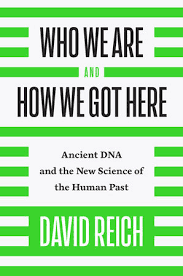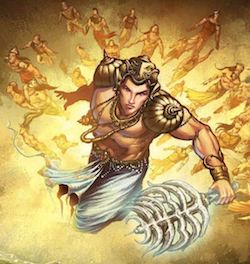 Since Who We Are and How We Got Here is out I thought I would spoil the “India chapter” (though you should buy the book!).
Since Who We Are and How We Got Here is out I thought I would spoil the “India chapter” (though you should buy the book!).
– The “Ancestral North Indians” are best modeled as a 50/50 ratio of Yamna-type people from the steppes & “Iranian farmers.” The implication is that the Indo-Aryans mixed with agriculturalists in the BMC on the way into South Asia.
– The “Ancestral South Indians” have about ~25% “Iranian farmer”, along with the indigenous component more like the Andaman Islanders.

David Reich clearly believes in a model of the ethnogenesis of South Asian populations detailed in A genetic chronology for the Indian Subcontinent points to heavily sex-biased dispersals. Also, I think I can now say in public when I had lunch with him he indicated that he thinks this is the most likely model. Also, the West Eurasian admixture into South Asian populations is “male-mediated.” R1a1a-z93 for the win!
He also believes there were several admixtures. He notes that his group’s 2013 paper, Genetic Evidence for Recent Population Mixture in India, reported two admixture events in North India, but one in South India. And the North Indian populations had the most recent event. This makes more sense if you consider that much of the admixture probably happened in the Northwest, as a mixed population spread across the subcontinent.
Reich contends that long tracts of ANI ancestry in some North Indians indicate that later people arrived from the first ANI wave. Also, several populations have an atypical Yamna-Iranian ratio in their ANI ancestry, being enriched for Yamna, and not so enriched for Iranian. These are all Brahmin groups.
Finally, he unmasks some of the backstories of difficulties collaborating with researchers in India, who have to be sensitive to cultural and political pressures. 2009’s Reconstructing Indian Population History was hailed in India as refuting the “Aryan invasion theory,” but the evidence was on the contrary, and I said so at the time.
In Who We Are and How We Got Here David Reich makes an explicit analogy between the Indian subcontinent and Europe. Both protrusions from Eurasia are characterized by a synthesis of indigenous hunter-gatherers, intrusive pastoralists from the Eurasian steppe, and migrating West Asian farmers.
Razib, this evidence suggests that many different peoples are genetically related to each other. How do we know where they originated? Do we know for sure that the Aryans came from one place? How do we know what that place is?
Also do we know when these Aryans originally came? 4,000 years ago? 14,000 years ago?
In the eastern scripture there is a description of the Chandra Vanksha (Moon dynasty as opposed to the Surya Vanksha or sun dynasty). Could the Aryan people be the Chandra Vanksha (also sometimes called Soma Vanksha)? They descend from Pururavas. Who was born long after Rama.
Pururavas’s descendants are the the Pandavas and Kauravas of the Maha Bharata.
Razib, this evidence suggests that many different peoples are genetically related to each other. How do we know where they originated? Do we know for sure that the Aryans came from one place? How do we know what that place is?
read the book.
ancient DNA makes it clear that the genetic signatures associated with aryan-like peoples (indo-european steppe more generally) only came into being 5,000 years ago. the earliest place that this genetic signature appears in the DNA dug up is in the pontic steppe.
almost all south asian and central asian r1a1a is the z93 lineage (Y chr). also found in central asian scythians. earliest evidence is in the sbruna people of eastern ukraine 4,000 years ago.
the mixing happened in stages. there was mixing later than 4,000 years ago. but ther was probably mixing way earlier (the ASI are evidence of this).
P.S. reich provides the same reason that i and others have for why the ‘out of india’ model is hard to square with reality: there is no ASI signal to the west or north of south asia. in contrast, there is plenty of ANI signal north and west of south asia.
In the eastern scripture there is a description of the Chandra Vanksha (Moon dynasty as opposed to the Surya Vanksha or sun dynasty). Could the Aryan people be the Chandra Vanksha (also sometimes called Soma Vanksha)? They descend from Pururavas. Who was born long after Rama.
i don’t know enuf of this stuff to say.
the genetics is getting clear. it’s up to people who know the oral ethnography to slot it into the appropriate places….
Indian geneticists seem to have been very skeptical of immigration into India (somewhat justified then) and unfortunately continue to do so now (A speech I watched by a leading geneticist at a nationalist forum attributed differences between north and south Indians to millenia of endogamy following their migration from africa, denying all major migrations to or from India). I do hope they eventually reconcile themselves with the data release the rakhigarhi study without too much delay. Perhaps we will get to see data from pakistan or central asia in the meantime
There was nothing new in this book. Same 2009 ASI-ANI study and 2017 endogamy study. Don’t waste your money on this book.
We still DON’T have ancient DNA from South Asia to say anything for sure. We need Paleolithic, Mesolithic and Neolithic aDNA. There will be many changes to this model once we do.
one way to square it all up for out of India group would perhaps be that everyone died out without leaving a trace. : ) But that wud be idiotic. what is the earliest contact between asi and others, latest . was there rigidity /hierarchical way in asi type people to begin with. how much of culture continues after new comers across the world. Finally, what can possibly change with new data over next 2 decades?. Thanks
preprint incoming soon i hear….
We still DON’T have ancient DNA from South Asia to say anything for sure. We need Paleolithic, Mesolithic and Neolithic aDNA. There will be many changes to this model once we do.
i’ve seen some results…won’t be published anytime soon. perhaps never?
Is it Rakhigarhi aDNA? what was the results, it’s Y-DNA and mtDNA? auDNA? was Reich/ Petersons new ASI model in the book based on those results?
I do know some results of Megalithic burials, one of which was mtdna M30, but not published since it was part of larger study.
I’m more interested in older pre-Neolithic samples, which would help explain ASI better than simply modeling it as Iran_Neo and SA forgers as they did in the book.
Is it Rakhigarhi aDNA? what was the results, it’s Y-DNA and mtDNA? auDNA? was Reich/ Petersons new ASI model in the book based on those results?
no, not based on aDNA. but if you to do drift stats and admixure with 75% “ASI” groups they are still more ‘west eurasian’ shifted than a pop just drifted from andaman would indicate.
I do know some results of Megalithic burials, one of which was mtdna M30, but not published since it was part of larger study.
there’s genome-wide. no idea when it will come out.
I’m more interested in older pre-Neolithic samples, which would help explain ASI better than simply modeling it as Iran_Neo and SA forgers as they did in the book.
at this point nepal, bdesh and pakistan might be best bet. but all these areas are marginal….
Using admixed moderns to explain such drifts is not very helpful. It is most likely that there was no West Eurasian until Neolithic, instead a cline with Central Asian forgers since Holocene-Mesolithic era.
Indian geneticists seem to already have Mesolithic and Neolithic data based on this abstract from May 2017, hopefully it will be published this year.
Title: E-P18.02 – Reconstructing the human population history of the Indian subcontinent using ancient population genomics.
Authors: N. Rai, K. Thangaraj1, V. Shinde;
Centre for Cellular and Molecular Biology, Hyderabad, India, Deccan College Post-Graduate and Research Institute, Pune, India.
Abstract: More than 1.3 billion people who live in Indian subcontinent correspond to several large ethnic groups who are highly diverse and complex. Importantly, India’s genetic past remains a subject a great debate due to numerous hypotheses surrounding population origins and migrations within and from outside India. In order to reconstruct and explain the patterns of genetic diversity evident in modern humans, an understanding of both past and present population dynamics is crucial. Several studies have shown that genetic data from ancient individuals are indispensable when reconstructing past population histories. We for the first time use the ancient genomics approach in South Asia to reconstruct the complex human population history of Indian Sub continent. We are exploring the recent technological advancement to directly test these hypotheses using ancient and modern human DNA in India. We have collected several ancient skeletal remains from different time scale of human civilization ranging from early Mesolithic, Neolithic, Harappan (Indus Valley civilization) and Megalithic culture. With the whole/partial genome NGS data, we are reconstructing the prehistoric peopling and migration of modern human in the Indian subcontinent. We are also testing the pervasive founder events and gradient of recessive genes accumulation by comparing the ancient genome with the modern human population of India.
http://www.abstractsonline.com/Plan/ViewAbstract.aspx?sKey=49b3ee97-60b3-43e0-a47b-7670d9defbaa&cKey=d5d0ae6a-8111-4268-b0e5-eecd91d1388a&mKey=%7b15A3630E-7769-4D64-A80A-47F190AC2F4F%7d
Additionally, Sri Lanka has paleolithic and Mesolithic remains from Fa Hien Cave, which will be very helpful in understanding population structure in SA if they get it tested.
a preprint with central asian stuff should be out soon. will show multiple turnovers from what i hear at different time depths.
The fact that the team involved keeps making periodic statements to the press, give me hope that they do have plans to eventually publish
The fact that the team involved keeps making periodic statements to the press, give me hope that they do have plans to eventually publish
well, their collab with non-indians is done for the obv. reasons.
they tend to ghost journalists now and then. people email me to tell me.
if they release their raw data there shouldn’t be any issue.
Thank you Khan Sahib for the enlightening post. This book will be a must read. I have learned a great deal from your posts over the years. Best wishes also for continued success in your science and journalism career.
If I may pose a question to you, on these genetic discussions in perhaps more low brow spaces the Andaman islanders and their shared lineage with South Asians is the topic of some comic ridicule. Can we assume the present day Andaman islanders are highly representative of some ancient population, first out of Africa, that peopled South and Southeast Asia, or is their unusual constitution more likely to be the product of a founder effect and genetic drift on their low population island habitat?
Paternal line: R1A, from North Bihar (Mithila), with possible ancient origins in Eastern UP (Bhojpur)
Maternal line: M, from Central Bihar (Magadha), with some known ancestry from Eastern UP and Karnataka
Bhumihar brahmin subcaste
Can we assume the present day Andaman islanders are highly representative of some ancient population, first out of Africa, that peopled South and Southeast Asia, or is their unusual constitution more likely to be the product of a founder effect and genetic drift on their low population island habitat?
they are drifted.
the problem is all modern pops are not representative of ASI.
remember, andman isles. connnected to southeast asia. not south asia.
How did rice farming get to India? Perhaps there was a 4th migration into India from East Asia?
Yes, thats a big question, which populations mediated the spread of rice cultivation. And who brought the African Sahel crop package to India of sorghum, millets, and certain legumes?